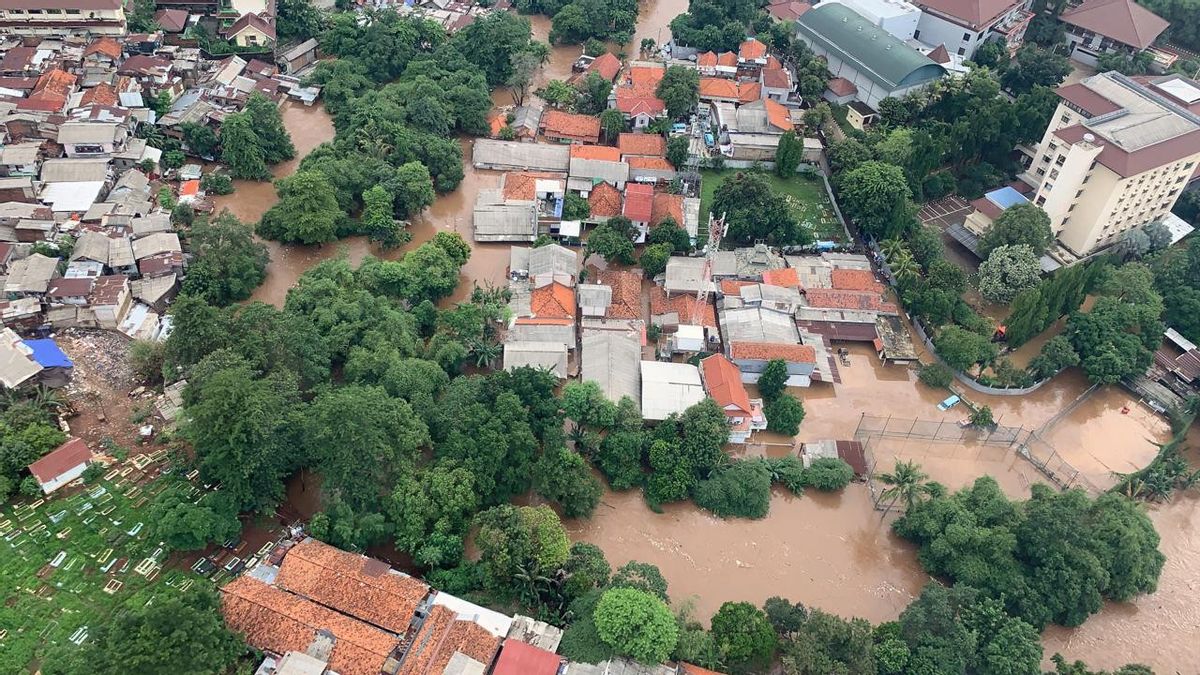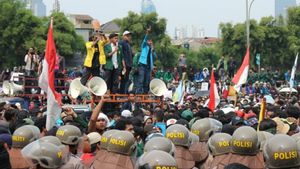JAKARTA - Flood disasters will continue to lurk DKI Jakarta and its surroundings if the provincial government does not immediately make flood prevention efforts. One of the ways to prevent flooding that can be done in medium and long steps is to arrange riverbank areas in Jakarta.
Urban planning observer from Trisakti University, Nirwono Yoga, said that there are at least 13 riverbanks in the DKI Jakarta area that must immediately be restructured either by normalization or naturalization. In addition to riverbanks, Yoga also focuses on the arrangement of settlements around water reservoirs such as there or lakes.
"In the medium term, flood prevention can be done in the first way, massive relocation of settlements on the banks of rivers and there, lakes, reservoirs or reservoirs to the nearest Rusunawa," Yoga told VOI reporters via text message, Thursday, December 2, adding There are about 109 lakes and lakes around the DKI Jakarta area that need to be normalized immediately.

In addition to the normalization or naturalization of riverbanks and hundreds of lakes or reservoirs, Yoga also emphasized that the repair of waterways must also be carried out by related agencies. "Rehabilitation of waterways will be phased in in stages together with the revitalization of sidewalks that are being carried out by DGH," he said.
Not only that, to accelerate water absorption from the ongoing rain, the DKI Jakarta Provincial Government and its staff are expected to accelerate the development of green open spaces (RTH) from an area of only 9.98 percent to 30 percent.
As for the fast-term steps of the DKI Jakarta Provincial Government after the flood disaster, Yoga said, DKI Jakarta Governor Anies Baswedan and his staff must ensure that the evacuation site works optimally to help flood victims.
In addition, Anies and his staff must immediately evaluate the flood-affected settlements and decide on their next plan. "For example, if there are settlements on the banks of the river that are affected by flooding, be sure to relocate them immediately this year," he said.
00:09 #Flood 20-30 cm on Jl. Deplu Raya Pesanggrahan, South Jakarta, to be careful when passing. @tyorah pic.twitter.com/tuv1UeJAuO
- TMC Polda Metro Jaya (@TMCPoldaMetro) January 1, 2020
Not yet the peak of the rainy season
Floods with different heights had occurred in DKI Jakarta on Wednesday, January 1, after raining since the day before. In fact, according to the Head of Sub-Directorate for Climate Information Analysis of the Meteorology, Climatology and Geophysics Agency (BMKG) Adi Ripaldi, although rain and floods have occurred at the beginning of the year, even at the turn of the year, this is not the peak of the rainy season.
"We (BMKG) predict that the peak of the rainy season will be in February-March," Adi told reporters in Jakarta, Wednesday, January 1, explaining that extreme rain had been predicted and was conveyed by his party through an early weather warning.
He also said that the rain that occurs continuously, such as on Tuesday 31 December to Wednesday 1 December, is also predicted to continue for the next 2 to 3 days. "The opportunity for rain is still the same for the Greater Jakarta area," he said.
On that occasion, Adi also reminded the people of DKI Jakarta and its surroundings that floods and puddles have the potential to occur every rainy season arrives. However, flooding and inundation in Jakarta are actually not only due to the rain factor in this area, but also rain in other areas such as Depok, Bogor, and surrounding areas.
# TinggiMukaAir # WarningDiniJKT # JAKI #PerluTahu UPDATE HIGH ADVANCE AIR
- BPBD DKI Jakarta (@BPBDJakarta) January 1, 2020
So that the community and the provincial government should pay attention to the drainage system so that flooding does not occur. In addition, people are also asked to be aware of rainfall at certain times because it is prone to flooding from other regions.
"DKI flood vigilance does not only focus on the peak months of the rainy season or February-March. However, we must be aware of the transition from the dry to rainy season and throughout the rainy season, from December 2019 to May 2020 because heavy rains may occur at any time. , "he concluded.
The English, Chinese, Japanese, Arabic, and French versions are automatically generated by the AI. So there may still be inaccuracies in translating, please always see Indonesian as our main language. (system supported by DigitalSiber.id)













